Human Flower Project
Torreya taxifolia: Seeing Is Inciting
Some plants are worthy of a pilgrimage. And as any pilgrim will tell you, such journeys have a way of changing one’s view of the world.
By James H. Wandersee and Renee M. Clary
EarthScholars™ Research Group
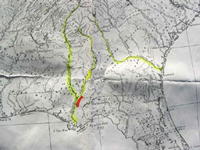 Surviving native range of Torreya taxifolia in northwestern Florida
Surviving native range of Torreya taxifolia in northwestern Florida
Map: The Torreya Guardians
The month is August. It’s sunny and nearly 100° Fahrenheit outside, with 92% relative humidity. We have journeyed by pick-up truck to sparsely populated northwest Florida, near the small city of Bristol, to an area long ago claimed to be the site of the Garden of Eden by one Elvy E. Callaway.
We have come for a live plant encounter with one of our nation’s most venerable, rare, and critically endangered species, Torreya taxifolia, commonly called the Torreya tree (pronounced tor-REY’-ah). Only about 500 specimens of this tree, a conifer and primitive member of the yew family, are estimated to be left in the wild, and this is the best place in the world to see some.
Having survived over 100 million years, according to the plant fossil record, the Torreya tree is now teetering on the edge of extinction. (The aforementioned Mr. Callaway thought this tree was the biblical gopher wood tree used to build Noah’s Ark—hence his Garden of Eden claim.)
It should be noted that the tree’s namesake is the famous American botanist John Torrey (1796-1873). His eponymous genus, Torreya, has six species—but Torreya taxifolia is by far the rarest. All six species are small-to medium-sized evergreen trees, ranging from 15 ft. to 60 ft. in height when mature. Torrey is also honored today through the famous Torrey Botanic Society Journal and the renowned Torrey Pines Golf Course near San Diego, California.
The trees we visited were growing inside Torreya State Park, a 12,000-acre Florida State Park which lies along the Apalachicola River. It cost us only $3 to enter the park, a well maintained, lush, and serenely beautiful area.
We found that few park visitors come here specifically to see the Torreya trees. Surprisingly, our analysis of 276 of the most recent handwritten, spontaneous visitor comments in the park’s guestbook uncovered no comments written specifically about the Torreya trees!
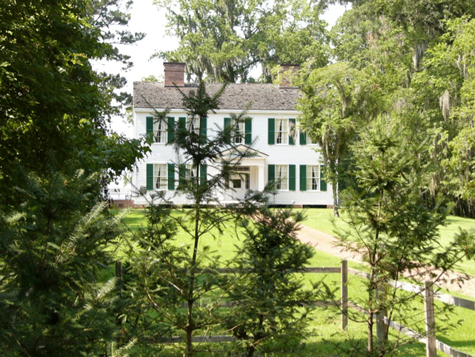
Enclosed Torreya tree exhibit
Photo: EarthScholars™ Research Group, 2011
The most convenient place to see two plots of living Torreya trees is alongside the walkway to the park’s signature Gregory House, a fully furnished plantation home built in 1849. We observed some visitors to the house breezing right by the Torreya tree displays without noticing, pausing, or reading the small and brief interpretive signs nearby. It is entirely possible that most visitors do not realize that Torreya State Park is a designated U.S. National Natural Landmark chiefly because of its Torreya TREES. Although there are tours of the historic house, there is no ranger interpretation program offered about the Torreya trees.
We wish more park visitors were drawn to the park using advertising focused upon the Torreya tree as a marquee plant—an attention-drawing category of plants which we have named and written about in another HFP article.
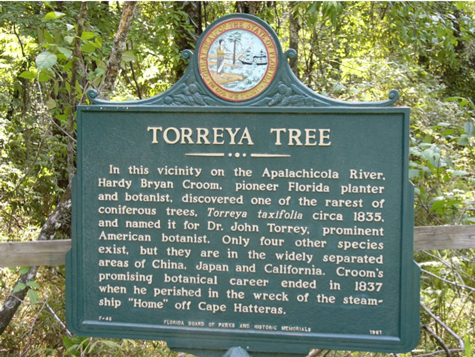
Information signage provided at the Torreya tree exhibit
Photo: EarthScholars™ Research Group, 2011
Would they be more intent on seeing these plants if they knew that the Torreya tree is a critically endangered species, one which has experienced a major decline in numbers due to fungal disease and post-glacial global warming? Visitors would be enlightened to know that this species has been the subject of a recovery effort called assisted migration: some seedlings are being moved farther north in experiments to relocate the plant to match its original climate zone, factoring in the effects of global warming.
The focused but highly active species support group, the Torreya Guardians, has an extensive and informative web site devoted to just such conservation issues. They provide an effective model of citizen science focused, laser-like, upon a single shared goal—in this case, saving the Torreya tree.
Ultimately, we would hope that families with children to come to this park to observe these trees, to see how they differ from other evergreens, to learn the importance of tree conservation, and to protect plant biodiversity themselves. Let them touch the dark, rich, sandy limestone soils of the Apalachicola River region and feel the stiff, prickly needle-like leaves of the Torreya’s ancient boughs. Otherwise, who will prevent our state and national parks from being closed in the battle against “government intrusion”? Who’ll keep the parklands from being harvested or sold off and commercially developed during times of financial stress?
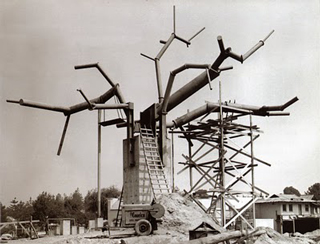
Construction by Disney of a replica Banyan tree for the Swiss Family Robinson treehouse
Photo: Blogspot
Florida is known throughout the U.S. as the home of Disney World, an “edutainment” theme park for families. But Disney World’s most famous tree, the Swiss Family Robinson treehouse tree, is made of cement and steel and weighs about 200 tons. The 60-ft. tall treehouse has been a favorite Adventureland attraction since the Magic Kingdom opened in October 1971, but it is not a real tree. Instead of roots, it has a 42-ft.-deep building foundation and more than 330,000 polyethylene plastic leaves! The tree is meant to mimic a Banyan tree, however Disney has dubbed it “Disneyodendron eximus” which means “a rare Disney tree.”
Is that artificial tree what we can expect from future urban landscape? We hope not. We want children to experience rare living plants like the Torreya tree in the wild. How else can they learn to appreciate and care about conserving such trees and to value plant biodiversity?
Parks can play a powerful role in science education, but only if the public visits and sees the bounty that, for now, is there.
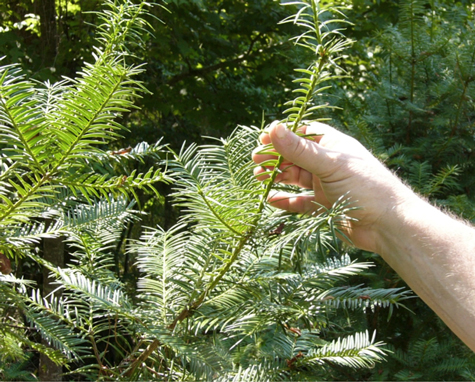
One of the authors examines the Torreya tree’s whorled branches
Photo: EarthScholars Research Group, 2011
One acre of trees provides enough oxygen to keep 18 people alive for a year, while also removing pollutants from the air. Our quality of life is enhanced by trees in so many ways.
We were inspired to undertake this trip by a historical remark that caught our eye. In the spring of 1875, the distinguished Harvard University botanist and plant taxonomist, Asa Gray, set out on a trip to the panhandle of Florida, to “make a pious pilgrimage to the secluded native haunts of that rarest of trees, the Torreya taxifolia.”
You, too, can follow in Gray’s footsteps!
Comments
Georgia, thank you for sharing that baby-naming information—What a beautiful and meaningful name for a new daughter!
We also greatly appreciated your reading recommendation.
The tree conservation hope you expressed is ours too. The English poet William Blake once wrote: “The tree which moves some to tears of joy is in the eyes of others only a green thing that stands in the way.” Those of us in the first group must continue to strive to educate and change the thinking of the latter group.
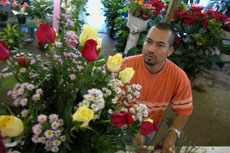

A classmate of mine (from a forestry school) named one of her daughters Torrey for the T. taxifolia in San Diego. The family lives in San Diego.
I recently learned of the U.S. National Natural Landmark designation while reading “Among the Ancients” by Jean Maloof.
I am surprised that a park with the NATURAL landmark designation highlights the architecture and not the NATURE (the trees).
Hopefully that Disney tree and others of its ilk stay RARE.